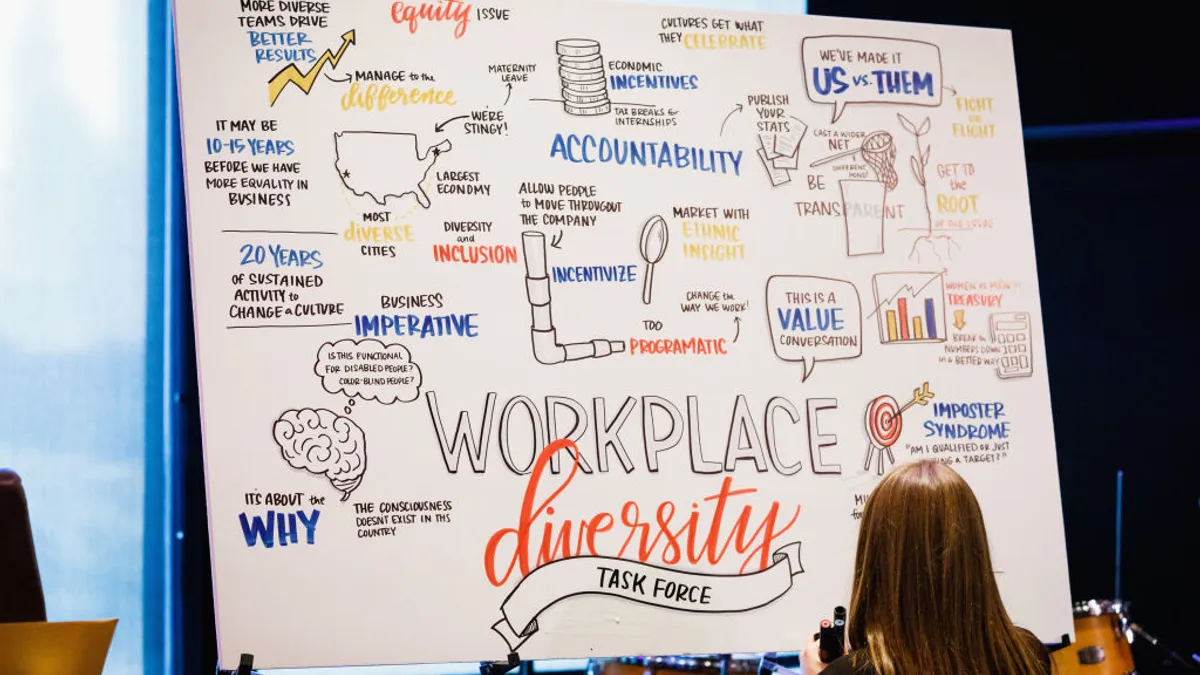In "Other Duties as Assigned," HR Dive editor Kate Tornone weighs in on employment trends, compliance best practices and, of course, the situations that require you to go above and beyond your normal duties. Today: increased ICE investigations and what that means for your I-9 process.
Recently, U.S. Immigration and Customs Enforcement (ICE) announced that it plans to increase worksite investigations by four- or five-fold. According to the agency’s website, these visits include checks for things like trafficking and money laundering. But assuming you’re ok on those fronts, HR’s main concern is going to be ensuring that its Form I-9 ducks are in a row. (The agency also just recorded its largest I-9 settlement ever, a whopping $95 million agreement with a Pennsylvania-based tree-pruning company.)
Best practices include training front-facing employees on what to do in the event of a site visit, reviewing existing I-9s, updating your workflow in light of some recent changes and educating yourself on potential future changes.
Prepare for an investigation
The first thing you need to do is ensure that forward-facing employees know what to do if ICE visits. If you’re a restaurant, for example, that’s probably your host and/or shift manager.
They need to know what you want them to say — or not say. And they need to know who to contact and how to reach them immediately. This should set off a chain of events that involves calling in an attorney who can review any paperwork that ICE provides, according to Lori Chesser, senior shareholder of the Davis Brown Law Firm and the chair of the firm's immigration department.
Certain access may need to be permitted right away, but HR has three days to produce I-9s. (But make sure you’re not subject to any exceptions; I’m looking at you, California.) This is where an experienced attorney can be particularly helpful, Chesser says, as some of the requests, like the timeline, can be negotiated. The same goes if you receive notice that they intend to fine you, Chesser added; “a lot of times there’s room to negotiate that as well.”
You may have some state law requirements that are set off by the visit and related requests, too. Again, in California (for example) employers must alert workers that their info is being handed over.
And if, while you’re gathering your I-9s for ICE, you discover some problems, document any corrective action you take and sign and date it, Chesser said. (U.S. Citizenship and Immigration Services (USCIS), the agency that issues the form, has some tips on this, too.) And please, don’t backdate anything. I’ve heard this over and over from immigration experts; any penalties you face for mistakes are likely to be far less than what you’d face for lying.
Finally, make sure you have copies of all of your I-9s before you hand them over, Chesser recommended. If the feds lose one, you’ll be on the hook for its absence unless you can prove that they lost it. And you may want to number those copies and make yourself a key so you can easily identify which form is missing.
Do your homework
You’re not going to love this one but, as you prepare to spruce up your I-9 process, Chesser says you need to read the form’s instructions. They’re helpful, not terribly long and they’ll prepare you for the next item on your to-do list: a self-audit. USCIS’ I-9 website and handbook are really good resources, too, she said.
The resources address basics, like record retention and eligibility documentation, but also cover special circumstances that can arise for workforces with a lot of temporary visas or in the case of a rehire.
Perform an I-9 audit
Your next step is reviewing your existing I-9 inventory. Despite the fact that the form has been around since the 80s, a lot of employers still struggle with it, Chesser says. Even the smallest infraction — like when an employee forgets to write his or her name at the top of the form’s second page — can result in a fine.
Chesser says that having an attorney perform the audit is preferable because they bring fresh eyes and know what to look for, but a self-audit is the next best thing. (If you do decide to go the DIY route, at least bring in a fresh set of eyes, Chesser says; it’s hard to review your own work.) ICE and the U.S. Department of Justice (DOJ) have a joint guidance on best practices and things to consider during your audit. In fact, DOJ’s Civil Rights Division has a whole package of guidance for employers on nondiscriminatory immigration compliance.
It’s also possible to find some middle ground. If you’re looking to control costs but still want to hire an attorney, Chesser recommends asking them to review 5% or 10% of your I-9s, depending on the size of your workforce. Send over a handful and ask them to look for trends, she said. When Chesser’s firm does these audits, they usually find something that’s awry, she said; “it’s just such a hard form.” And after handing over her findings, she performs a training, teaching HR how to review the rest in a self-audit.
If you or your lawyer do find problems, you’ll need to fix them — but in the proper way, as mentioned above. And, whatever it is that you've been doing incorrectly, make sure you stop the practice and train everyone involved.
And yes, audits come with their own risks but they may very well be outweighed by the benefits of bringing your I-9s and your workforce into compliance.
Rethink your workflow
Once your existing I-9s are in good shape, it’s time to look at your future workflow. There have been a few recent changes to the form — and to the way we work — that have complicated compliance.
For starters, the feds replaced the I-9 twice this year. The first time, the government introduced an electronic version of the form. (By the way, if you've been trying to make that switch but having trouble, it's because you can't view the form in a browser; you have to download it and then open it with an up-to-date version of Adobe Acrobat Reader.) The second time the form was replaced this year, the government updated the list of documents that can serve as proof of eligibility to work. And a third update could be on the way.
Why does this matter? Using an outdated form is a violation by itself. If you’ve been assembling a bunch of new-hire packets in advance, you may need to rethink that. Ideally, you should be printing out a new form (if you’re not using the digital version) for each person as you need it.
Next, you need to consider whether you need employees to complete the form earlier than you’ve been requiring. Previously, the instructions said that employees needed to complete their I-9 by the end of their first day of work. Now, they say “no later than the first day of employment.” It doesn’t necessarily say that it must be completed before they start work but, USCIS must have removed those words for a reason, right?
“It was supposed to be clarifying but I don’t know that it is particularly clarifying,” Chesser said. In light of this, all employees should complete the form as part of their onboarding process or even before starting work, as long as they’ve accepted a job offer. It’s fine to say “come with this completed on the first day,” she said. (This all applies to Section 1 of the form; under most circumstances, workers have three days to produce the eligibility documents required in Section 2.)
An external shift — toward remote work — is adding an additional layer to your workflow. Form I-9 requires that an employer’s representative review an employee’s documentation in person. Scans, faxes and FaceTime don’t count. If you can’t literally hold the documents in your hands because your new hire is working remotely, you need to find someone who can, USCIS says. There are companies offering this kind of service nationwide, but really, it can be almost anyone. (I say “almost” because — you guessed it — California.)
Stay on your toes
As I mentioned earlier, there may be yet another new Form I-9 coming your way soon. The best way to ensure you’re using the most recent version is to get the form straight from USCIS’ website as needed for each new hire.
You also can keep an eye on the regulations that would require the next potential update — an Obama-era rule allowing entrepreneurs from other countries to set up shop in the U.S. It’s set to take effect in March and, if the Trump administration allows that to happen, Form I-9 will need to be revised to add those individuals’ documentation to the list of acceptable eligibility documents. It was initially thought that the administration would block the rule but a group of venture capitalists has sued, in an effort to prevent it from doing so, and some conservatives have spoken out in favor of allowing it to take effect.
Finally, HR will need to keep an eye out for another trend: I-9 scam emails. USCIS announced just a few days ago that employers have been receiving emails requesting I-9 info. They appear to come from USCIS but there’s one giant red flag: Employers are not required to submit I-9s to USCIS. The agency has asked employers to report any such requests to the Federal Trade Commission.



















